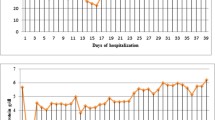Abstract
A single episode of systemic capillary leak syndrome is reported in a HIV-positive patient. The shock had necessitated the infusion of large amounts of fluid with concomitant diffuse swelling and weight gain leading to compartment syndrome of both legs. This required surgical relief. The initial high hematocrit (62%) and low serum protein concentration (48 g/l) with normal factor V (molecular weight above 300 000) concentrations are the hallmark of capillary leak when they are associated with hypovolemic shock. It must be emphasized that fluid resuscitation may worsen the muscle damage with ultimate compartment syndrome. Therefore, it appears reasonable to monitor muscular pressure during volume expansion in patients with capillary leak syndrome, severe shock and muscular swelling.
Similar content being viewed by others
References
Atkinson JP, Waldmann TA, Stein SF, Gelfand JA, Mc Donald WJ, Heck LM, Cohen EL, Kaplan AP, Franck MM (1977) Systemic capillary leak syndrome and monoclonal IgG gammapathy. Medicine (Baltimore) 56:225–239
Horwith M, Hagstrom JWC, Riggins RCK, Luckey EH (1967) Hypovolemic shock and edema due to increase capillary permeability. J Am Med Assoc 200:101–104
George C, Regnier B, Le Gall JR, Gastinne H, Carlet J, Rapin M (1978) Hypoyolaemic shock with oedema due to increased capillary permeability. Intensive Care Med 4:159–163
Landis EM (1946) Capillary permeability and the factors affecting the composition of capillary filtrate. Ann NY Acad Sci 46:713
Stapf P, Dudeffant P, Dupuich Y, Haglund P (1986) Choc hypovolérnique par augmentation de la perméabilité capillaire cyclique idiopathique. Réan Soins Intens Med Urg 2:143–145
Devictor D (1985) Mesure des pressions intramusculaires au cours du choc septique chez l'enfant. Réan Soins Intens Med Urg 1:27–28
Whitesides TE, Haney TC, Morimoto K, Harada H (1975) Tissue pressure measurements as a determinant for the need of fasciotomy. Clin Orthop 113:43–51
Ashton H (1975) The effect of increased tissue pressure on blood flow. Clin Orthop 113:15–25
Braquet P (1986) Proofs of involvement of PAF-acether in various immune disorders using BN 52021 (ginkgolide B): a powerful PAF-acether antagonist isolated from ginkgo-biloba L. Adv Prostaglandin Thromboxane Leukotriene Res 16:179–198
Lagrue G, Rahbar K, Behar A, Sobel A, Laurent J (1986) Choc récidivant avec gammapathie monoclonale. Traitement en phase aiguë et chronique par l'extrait de Ginkgo-biloba oral et parentéral. Presse Med 15:1554–1555
Author information
Authors and Affiliations
Rights and permissions
About this article
Cite this article
Guidet, B., Guerin, B., Maury, E. et al. Capillary leakage complicated by compartment syndrome necessitating surgery. Intensive Care Med 16, 332–333 (1990). https://doi.org/10.1007/BF01706361
Received:
Accepted:
Issue Date:
DOI: https://doi.org/10.1007/BF01706361




